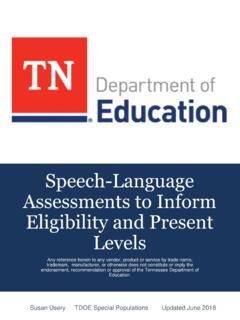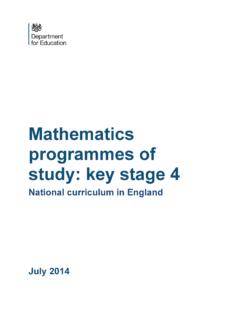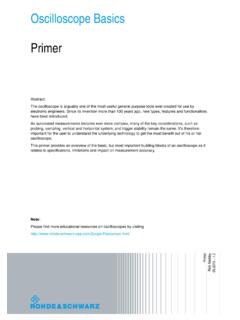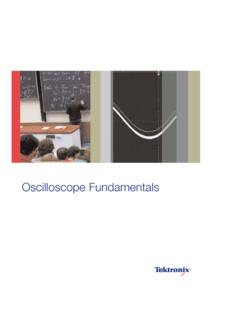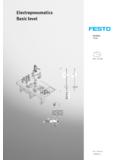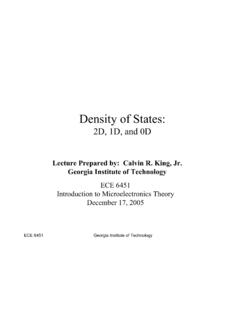Transcription of Mathematics programmes of study: key stage 3
1 Mathematics programmes of study : key stage 3 National curriculum in England September 2013 Mathematics key stage 3 2 Purpose of study Mathematics is a creative and highly inter-connected discipline that has been developed over centuries, providing the solution to some of history s most intriguing problems. It is essential to everyday life, critical to science, technology and engineering, and necessary for financial literacy and most forms of employment. A high-quality Mathematics education therefore provides a foundation for understanding the world, the ability to reason mathematically, an appreciation of the beauty and power of Mathematics , and a sense of enjoyment and curiosity about the subject. Aims The national curriculum for Mathematics aims to ensure that all pupils: become fluent in the fundamentals of Mathematics , including through varied and frequent practice with increasingly complex problems over time, so that pupils develop conceptual understanding and the ability to recall and apply knowledge rapidly and accurately.
2 Reason mathematically by following a line of enquiry, conjecturing relationships and generalisations, and developing an argument, justification or proof using mathematical language can solve problems by applying their Mathematics to a variety of routine and non-routine problems with increasing sophistication, including breaking down problems into a series of simpler steps and persevering in seeking solutions. Mathematics is an interconnected subject in which pupils need to be able to move fluently between representations of mathematical ideas. The programme of study for key stage 3 is organised into apparently distinct domains, but pupils should build on key stage 2 and connections across mathematical ideas to develop fluency, mathematical reasoning and competence in solving increasingly sophisticated problems. They should also apply their mathematical knowledge in science, geography, computing and other subjects.
3 Decisions about progression should be based on the security of pupils understanding and their readiness to progress to the next stage . Pupils who grasp concepts rapidly should be challenged through being offered rich and sophisticated problems before any acceleration through new content in preparation for key stage 4. Those who are not sufficiently fluent should consolidate their understanding, including through additional practice, before moving on. Information and communication technology (ICT) Calculators should not be used as a substitute for good written and mental arithmetic. In secondary schools, teachers should use their judgement about when ICT tools should be used. Mathematics key stage 3 3 Spoken language The national curriculum for Mathematics reflects the importance of spoken language in pupils development across the whole curriculum cognitively, socially and linguistically.
4 The quality and variety of language that pupils hear and speak are key factors in developing their mathematical vocabulary and presenting a mathematical justification, argument or proof. They must be assisted in making their thinking clear to themselves as well as others and teachers should ensure that pupils build secure foundations by using discussion to probe and remedy their misconceptions. Attainment targets By the end of key stage 3, pupils are expected to know, apply and understand the matters, skills and processes specified in the relevant programme of study . Schools are not required by law to teach the example content in [square brackets] or the content indicated as being non-statutory . Mathematics key stage 3 4 Key stage 3 Working mathematically Through the Mathematics content, pupils should be taught to: Develop fluency consolidate their numerical and mathematical capability from key stage 2 and extend their understanding of the number system and place value to include decimals, fractions, powers and roots select and use appropriate calculation strategies to solve increasingly complex problems use algebra to generalise the structure of arithmetic, including to formulate mathematical relationships substitute values in expressions, rearrange and simplify expressions, and solve equations move freely between different numerical, algebraic, graphical and diagrammatic representations [for example, equivalent fractions, fractions and decimals, and equations and graphs]
5 Develop algebraic and graphical fluency, including understanding linear and simple quadratic functions use language and properties precisely to analyse numbers, algebraic expressions, 2-D and 3-D shapes, probability and statistics. Reason mathematically extend their understanding of the number system; make connections between number relationships, and their algebraic and graphical representations extend and formalise their knowledge of ratio and proportion in working with measures and geometry, and in formulating proportional relations algebraically identify variables and express relations between variables algebraically and graphically make and test conjectures about patterns and relationships; look for proofs or counter-examples begin to reason deductively in geometry, number and algebra, including using geometrical constructions interpret when the structure of a numerical problem requires additive, multiplicative or proportional reasoning explore what can and cannot be inferred in statistical and probabilistic settings, and begin to express their arguments formally.
6 Mathematics key stage 3 5 Solve problems develop their mathematical knowledge, in part through solving problems and evaluating the outcomes, including multi-step problems develop their use of formal mathematical knowledge to interpret and solve problems, including in financial Mathematics begin to model situations mathematically and express the results using a range of formal mathematical representations select appropriate concepts, methods and techniques to apply to unfamiliar and non-routine problems. Subject content Number Pupils should be taught to: understand and use place value for decimals, measures and integers of any size order positive and negative integers, decimals and fractions; use the number line as a model for ordering of the real numbers; use the symbols =, , <, >, , use the concepts and vocabulary of prime numbers, factors (or divisors), multiples, common factors, common multiples, highest common factor, lowest common multiple, prime factorisation, including using product notation and the unique factorisation property use the four operations, including formal written methods, applied to integers, decimals, proper and improper fractions, and mixed numbers, all both positive and negative use conventional notation for the priority of operations, including brackets, powers, roots and reciprocals recognise and use relationships between operations including inverse operations use integer powers and associated real roots (square, cube and higher)
7 , recognise powers of 2, 3, 4, 5 and distinguish between exact representations of roots and their decimal approximations interpret and compare numbers in standard form A x 10n 1 A<10, where n is a positive or negative integer or zero work interchangeably with terminating decimals and their corresponding fractions (such as and 27 or and 83) define percentage as number of parts per hundred , interpret percentages and percentage changes as a fraction or a decimal, interpret these multiplicatively, express one quantity as a percentage of another, compare two quantities using percentages, and work with percentages greater than 100% interpret fractions and percentages as operators Mathematics key stage 3 6 use standard units of mass, length, time, money and other measures, including with decimal quantities round numbers and measures to an appropriate degree of accuracy [for example, to a number of decimal places or significant figures]
8 Use approximation through rounding to estimate answers and calculate possible resulting errors expressed using inequality notation a<x b use a calculator and other technologies to calculate results accurately and then interpret them appropriately appreciate the infinite nature of the sets of integers, real and rational numbers. Algebra Pupils should be taught to: use and interpret algebraic notation, including: ab in place of a b 3y in place of y + y + y and 3 y a2 in place of a a, a3 in place of a a a; a2b in place of a a b ba in place of a b coefficients written as fractions rather than as decimals brackets substitute numerical values into formulae and expressions, including scientific formulae understand and use the concepts and vocabulary of expressions, equations, inequalities, terms and factors simplify and manipulate algebraic expressions to maintain equivalence by: collecting like terms multiplying a single term over a bracket taking out common factors expanding products of two or more binomials understand and use standard mathematical formulae.
9 Rearrange formulae to change the subject model situations or procedures by translating them into algebraic expressions or formulae and by using graphs use algebraic methods to solve linear equations in one variable (including all forms that require rearrangement) work with coordinates in all four quadrants recognise, sketch and produce graphs of linear and quadratic functions of one variable with appropriate scaling, using equations in x and y and the Cartesian plane interpret mathematical relationships both algebraically and graphically Mathematics key stage 3 7 reduce a given linear equation in two variables to the standard form y = mx + c; calculate and interpret gradients and intercepts of graphs of such linear equations numerically, graphically and algebraically use linear and quadratic graphs to estimate values of y for given values of x and vice versa and to find approximate solutions of simultaneous linear equations find approximate solutions to contextual problems from given graphs of a variety of functions, including piece-wise linear, exponential and reciprocal graphs generate terms of a sequence from either a term-to-term or a position-to-term rule recognise arithmetic sequences and find the nth term recognise geometric sequences and appreciate other sequences that arise.
10 Ratio, proportion and rates of change Pupils should be taught to: change freely between related standard units [for example time, length, area, volume/capacity, mass] use scale factors, scale diagrams and maps express one quantity as a fraction of another, where the fraction is less than 1 and greater than 1 use ratio notation, including reduction to simplest form divide a given quantity into two parts in a given part:part or part:whole ratio; express the division of a quantity into two parts as a ratio understand that a multiplicative relationship between two quantities can be expressed as a ratio or a fraction relate the language of ratios and the associated calculations to the arithmetic of fractions and to linear functions solve problems involving percentage change, including: percentage increase, decrease and original value problems and simple interest in financial Mathematics solve problems involving direct and inverse proportion, including graphical and algebraic representations use compound units such as speed, unit pricing and density to solve problems.










